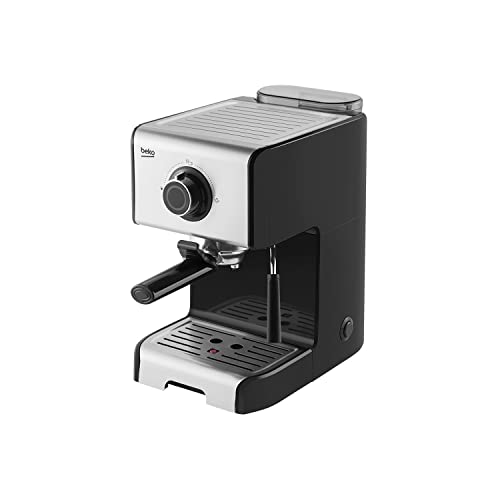How Does Machine Espresso Work?
Machine espresso employs precise pressure and mind-blowing filter technology to make the perfect cup of coffee. But how exactly does it work?
In order to make espresso hot water is pushed under pressure through finely ground coffee. The process is similar to that of making drip coffee. However, the pressure is the main difference.
The Group Head
The group head is the portafilter that you insert when brewing espresso. It is responsible for dispersing the water into the portafilter and controlling the pressure of the extraction. There are numerous kinds of group heads each with its own advantages and disadvantages. Some are specifically designed for the stability of temperature while some are designed to handle pre-infusion. Others are made to control the lever. Some come with a range of features, like the E61 one,
espressomachines which is to be the most popular among baristas due to its ability to offer multiple benefits in a single package.
As you can see from the above photo, the group head is fitted with a variety of notches. It is possible to place your portafilter in these notches and
Espressomachines then twist the head to lock it. A gasket made of rubber is positioned inside the notches, which helps create a seal as you insert your portafilter. The notches permit the precise placement of the portafilter. This is essential for an even extraction.
The group head not only lets you to place your portafilter easily but also maintains the temperature at a constant level. It does this by circulating hot water through the brew basket, and around the portafilter to ensure that it's always at the correct temperature to extract. This is crucial, since even a few degrees can mean the difference between good and great espresso.
The Pump
In contrast to piston machines that are manually operated, which rely on a lever that pressurize water, rotating espresso machines rely upon motorized pumps to supply the nine atmospheric bars of pressure that are required to extract espresso. The pressure is built by pumping water through a heat-exchanger and then through the ground coffee.
Pumps are typically less expensive and last for longer than piston-driven machines. However, both kinds of machines can degrade due to overuse and poor cleaning. Pumps are also more complex mechanically, and can add to prices of even simpler models.
Certain espresso machines remove the pump entirely and use steam pressure to brew espresso. This can result in over-extraction because the boiler that makes steam also heats the water until it comes to a boil. The machines also need to continually rebuild their pressure between cups. This requires energy and time.
Many espresso machines employ the rotary or vibration pump, with a vibration model that uses a vibrating disc to create pressure, and an rotary model that pushes hot water through the grounds at high speed. Both machines can make great espresso, however rotary machines are more quiet, durable and less likely to fail.
The Boiler
The boiler is the part that heats water to the ideal temperature for extraction. The steam that is created will eventually reach the portafilter, which is the container that holds the espresso
coffee espresso machines grounds. The steam is then channeled into the cup. The steam creates pressure to push through the coffee grounds. This creates a layer crema on top. This is a sign of a great espresso.
There are three different types of
espresso machine with milk frother machines,
espressomachines each having distinct pumps and the temperature of the brew. There are a variety of ways in which the brew could be controlled, as well as the dimensions of the cup the machine can produce.
The first
espresso maker barista machines were steam-types. The earliest espresso machines were steam types. This resulted in the coffee tasting bitter and burnt. The modern espresso machine was created by the Milanese producers Luigi Bezzerra & Desiderio Pavoni.
The most well-known espresso machine is a semiautomatic that has an electric pump. When people think of espresso machines, they think of these machines. Semi-automatic machines require you to grind and tamp the beans on your own, but the pump regulates the flow of water and pressure. This is a perfect combination of human control and mechanised reliability.
The Filter
Espresso machines typically have filters that separate the grounds of coffee from hot water. The filter is also an essential component of the machine's temperature control, since it stops overheating.
Filters also aid in flavor, as it permits a longer flowering phase. This helps the beans release their nuances and gives an opportunity for a better extraction.
However, it is important to keep in mind that even a good filter could result in a bad cup of coffee, since the quality of the beans and extraction are crucial.
This is where the magic happens, and it's what makes an espresso really taste good. The grouphead (also known as the brewhead) is where you put the portafilter - the thingy used to place the
coffee and espresso maker grounds into, when making espresso.
Steam-driven
espresso coffee machine with milk frother machines use hot water that is heated in an airtight container to make steam. The steam then pushes hot water through the grounds of coffee at high pressure. These machines are less expensive and are easier for the user to maintain than pumps-driven models. However, they are limited in their ability to provide the ideal conditions for brewing since they are only operating at 1-1.5 bars of pressure. However, the perfect shot requires 9-10 bars.
In recent years, espresso machines driven by a compressed air pump have become increasingly popular. They make use of an air compressor to force hot water into the ground and are more mobile than steam-driven electric espresso machines.

